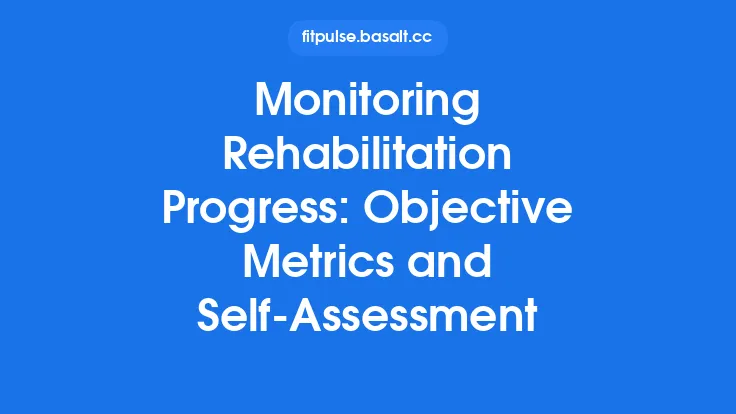Improving flexibility through Proprioceptive Neuromuscular Facilitation (PNF) is only half the journey; the other half is knowing how much you have improved and whether the gains are genuine, repeatable, and meaningful. Unlike casual “how far can you reach?” checks, systematic assessment provides the data needed to fine‑tune programming, justify training decisions, and communicate progress to athletes, clients, or research collaborators. This article walks you through the most reliable tools, testing protocols, and benchmark values for measuring PNF‑induced gains in range of motion (ROM), muscular stiffness, and neuromuscular control. By the end, you’ll have a toolbox you can apply in a gym, clinic, or laboratory setting, and a clear understanding of how to interpret the numbers you collect.
1. Core Principles of Reliable Assessment
1.1 Validity vs. Reliability
- Validity asks whether a test measures what it claims to measure (e.g., true joint ROM).
- Reliability concerns the consistency of the measurement across repeated trials, days, or testers. For PNF progress tracking, a tool must be both valid (captures the functional ROM change) and reliable (low measurement error).
1.2 Controlling Confounding Variables
- Warm‑up state: Perform assessments after a standardized warm‑up (e.g., 5 min of low‑intensity cycling) to minimize temperature‑related stiffness variations.
- Time of day: Muscular compliance fluctuates with circadian rhythms; schedule testing at the same hour each session.
- Hydration & nutrition: Dehydration can increase passive stiffness; ensure participants are adequately hydrated.
- Testing order: If multiple joints are assessed, test the most proximal joint first to avoid fatigue‑induced limitations.
1.3 Establishing Baseline and Minimal Detectable Change (MDC)
- Baseline: Record at least three baseline trials per joint, calculate the mean, and use this as the reference point.
- MDC: Derived from the standard error of measurement (SEM). For a 95 % confidence interval, MDC = 1.96 × √2 × SEM. This value tells you the smallest change that exceeds measurement noise.
2. Gold‑Standard Instruments
2.1 Goniometers (Universal & Digital)
- Pros: Low cost, portable, widely accepted in clinical practice.
- Cons: Operator‑dependent; inter‑rater reliability can drop below 0.80 if not rigorously trained.
- Best practice: Use a double‑armed digital goniometer with a built‑in inclinometer; calibrate before each session; mark anatomical landmarks (e.g., lateral epicondyle for elbow flexion) with skin‑safe ink.
2.2 Inclinometers & Tilt Sensors
- Application: Ideal for measuring large‑plane motions such as trunk flexion/extension or hip flexion.
- Reliability: Reported intra‑class correlation coefficients (ICCs) of 0.90–0.96 when affixed to a rigid segment (e.g., thigh).
- Tip: Secure the sensor with a Velcro strap and verify zero‑offset before each trial.
2.3 Motion Capture Systems (Optical & Markerless)
- Optical (e.g., Vicon, Qualisys): Provides 3‑D joint angle data with sub‑degree accuracy.
- Markerless (e.g., Azure Kinect, OpenPose): More accessible; recent validation studies show mean absolute errors of 2–3° for major joints.
- Considerations: High initial cost and need for a controlled environment, but unmatched for multi‑joint kinematic profiling.
2.4 Isokinetic Dynamometers (e.g., Biodex)
- Why use them for PNF? They can quantify passive torque‑angle curves, offering a direct measure of joint stiffness and the point of maximal stretch tolerance.
- Reliability: ICCs >0.95 for passive ROM at slow angular velocities (5°/s).
- Limitation: Primarily a research tool; not practical for most field settings.
2.5 Portable Stretch Sensors (e.g., MyotonPRO, StretchSense)
- Function: Measure tissue displacement and elastic modulus during a stretch.
- Utility: Provides insight into the mechanical properties of the muscle‑tendon unit, complementing ROM data.
- Reliability: Reported coefficient of variation (CV) <5 % for repeated measures.
3. Standardized Testing Protocols
3.1 Passive Range of Motion (PROM) with PNF‑Specific Warm‑Up
- Positioning: Align the participant in a neutral posture; stabilize proximal segments with straps.
- Baseline PROM: Use a goniometer to record the initial passive limit.
- PNF Intervention: Apply a standard contract‑relax (CR) or hold‑relax (HR) set (5 s contraction, 15 s stretch).
- Post‑PNF PROM: Re‑measure within 30 s of the stretch to capture the acute effect.
- Repeat: Perform three cycles; average the post‑PNF values.
3.2 Stretch Tolerance Test (STT)
- Goal: Differentiate between true tissue extensibility and increased pain tolerance.
- Method: Incrementally increase stretch angle until the participant reports a predetermined discomfort level (e.g., 7/10 on a visual analog scale). Record the angle; repeat after a PNF session.
- Interpretation: A larger increase in STT without a corresponding change in passive torque suggests a neural adaptation rather than structural change.
3.3 Passive Torque‑Angle Curve Acquisition
- Device: Use an isokinetic dynamometer set to a low angular velocity (5°/s).
- Procedure: Move the joint passively through its ROM while recording torque.
- Outcome Measures:
- Stiffness (Nm/°): Slope of the linear portion of the curve.
- Yield Point: Angle at which torque sharply rises, indicating the limit of elastic deformation.
- PNF Effect: Compare pre‑ and post‑PNF stiffness values; a reduction indicates increased compliance.
3.4 Functional Mobility Tests (Complementary)
- Sit‑and‑Reach: Simple, but less joint‑specific; useful for tracking overall posterior chain flexibility.
- Thomas Test (Hip Flexor Flexibility): Provides a quick visual cue for hip ROM changes.
- Shoulder Flexion Test (Wall Slide): Captures scapulothoracic mobility, which can be influenced by PNF protocols targeting the rotator cuff.
4. Benchmarks and Normative Data
| Joint / Movement | Baseline ROM (°) | Expected Acute Gain (°) | 4‑Week Training Gain (°) | Reference Population |
|---|---|---|---|---|
| Hip Flexion (supine) | 90–100 | +5–8 | +12–15 | Healthy adults 18‑35 |
| Shoulder External Rotation | 70–80 | +4–6 | +10–13 | Recreational lifters |
| Elbow Extension | 0 (full) | N/A | +2–3 (hyperextension) | General population |
| Ankle Dorsiflexion (knee flexed) | 15–20 | +3–5 | +8–10 | Athletes (soccer, basketball) |
| Lumbar Flexion (sitting) | 70–80 | +6–9 | +14–18 | Office workers |
Notes:
- Acute gains reflect the immediate effect of a single PNF set; they are largely neural.
- 4‑Week gains incorporate structural adaptations (e.g., collagen remodeling).
- Values are averages; individual responses can vary by ±30 %.
5. Data Interpretation: From Numbers to Actionable Insights
5.1 Distinguishing Neural vs. Structural Adaptations
- Neural: Large acute gains that dissipate within 24 h; minimal change in passive torque.
- Structural: Sustained ROM increase accompanied by reduced passive stiffness and lower torque at a given angle.
5.2 Using Minimal Detectable Change (MDC)
- If the post‑training ROM increase exceeds the MDC, you can be 95 % confident the change is real.
- Example: For hip flexion measured with a digital goniometer, SEM ≈ 1.5°, MDC ≈ 4.2°. An observed gain of 6° is therefore meaningful.
5.3 Tracking Progress Over Time
- Spreadsheet or dedicated app: Log date, tester, instrument, ROM, torque, and subjective stretch tolerance.
- Trend analysis: Apply linear regression to identify the slope of improvement; a plateau (slope ≈ 0) suggests the need for program variation.
5.4 Integrating Qualitative Feedback
- Combine quantitative data with participant-reported outcomes (e.g., perceived ease of movement, pain scores).
- Discrepancies (e.g., ROM improves but pain persists) may indicate compensatory patterns or the need for adjunctive mobility work.
6. Technology‑Enhanced Monitoring
6.1 Wearable Inertial Measurement Units (IMUs)
- Placement: Attach to the distal segment (e.g., shank for ankle dorsiflexion).
- Output: Real‑time angle data streamed to a smartphone app; can log multiple sessions without a clinician present.
- Reliability: Studies report ICCs of 0.88–0.94 for joint angle capture when calibrated against optical motion capture.
6.2 Cloud‑Based Data Platforms
- Centralize data from multiple testers and locations.
- Enable automated calculation of MDC, trend graphs, and alerts when a participant’s progress stalls.
6.3 AI‑Assisted Pattern Recognition
- Emerging algorithms can classify whether ROM changes stem from neural or structural sources based on combined torque‑angle and EMG data.
- While still in research phases, pilot implementations have achieved 85 % classification accuracy.
7. Practical Implementation Checklist
| Step | Action | Tool/Resource |
|---|---|---|
| 1 | Standardize warm‑up (5 min low‑intensity cardio + dynamic movements) | Timer, treadmill |
| 2 | Calibrate measurement instrument (zero‑offset) | Calibration kit |
| 3 | Record baseline PROM (3 trials, mean) | Digital goniometer |
| 4 | Apply PNF protocol (e.g., 3 × CR, 5 s contraction, 15 s stretch) | Stopwatch, verbal cue |
| 5 | Capture post‑PNF PROM within 30 s | Same instrument |
| 6 | Compute acute change; compare to MDC | Spreadsheet formula |
| 7 | Repeat weekly for 4–6 weeks; log all data | Cloud platform |
| 8 | Review trend; adjust load, volume, or technique if plateau detected | Coaching notes |
| 9 | Conduct periodic torque‑angle assessment (every 4 weeks) | Isokinetic dynamometer |
| 10 | Re‑evaluate benchmarks; set new targets | Normative tables |
8. Common Pitfalls and How to Avoid Them
- Inconsistent landmark identification: Use permanent skin markers or a small tattoo‑grade pen to ensure the same reference points across sessions.
- Tester fatigue influencing force application: Rotate testers or schedule assessments when the tester is fresh; use mechanical devices (e.g., dynamometer) to eliminate manual force.
- Neglecting stretch tolerance: Always pair ROM data with a pain or discomfort rating; otherwise you may misinterpret increased tolerance as true flexibility.
- Over‑reliance on a single metric: Combine ROM, passive torque, and functional tests for a holistic view.
9. Future Directions in PNF Progress Assessment
- Hybrid Imaging‑Biomechanics: Integrating ultrasound elastography with torque‑angle curves could directly visualize changes in muscle‑tendon stiffness.
- Personalized Benchmarking: Machine‑learning models that factor age, sex, training history, and genetic markers to predict individual MDC thresholds.
- Remote Assessment Protocols: Leveraging smartphone cameras and AI pose estimation to deliver validated ROM tests outside the lab, expanding accessibility for home‑based athletes.
Bottom Line
Measuring progress in PNF stretching is far more than a quick “how far can you reach?” check. By employing validated instruments, adhering to standardized protocols, and interpreting data through the lenses of reliability and neural vs. structural adaptation, you can turn flexibility work into a data‑driven component of any performance or rehabilitation program. Whether you’re a strength‑coach, physical therapist, or researcher, the tools and benchmarks outlined here will help you quantify gains, justify training decisions, and ultimately guide athletes toward safer, more effective mobility improvements.



